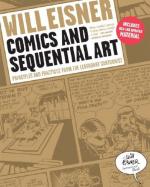
|
| Name: _________________________ | Period: ___________________ |
This test consists of 5 short answer questions, 10 short essay questions, and 1 (of 3) essay topics.
Short Answer Questions
1. What is often predetermined by the nature of the story?
2. What dominates the reader's initial response?
3. What is the title of Chapter 6?
4. What is the most universal image in sequential art?
5. What does reading provide for the artist that he or she can use?
Short Essay Questions
1. Explain why comic writers first create a written script of their idea and story/plot, including narrative and dialog (balloons).
2. How can posture and gesture give insight into a character's lifestyle and allow sociological observations?
3. Why does artwork dominate the reader's initial response?
4. Why do people make important daily judgments about faces?
5. Why are the body's gestures and postures stored in the artist's memory as a non-verbal vocabulary?
6. How has technology challenged the individuality of artists?
7. What temptation do artists have to detract from the text?
8. Why are technical skills mandatory for comic book artists?
9. Why does Eisner reproduce the story written by Jules Feiffer that was never published?
10. Why are comic book artists frequently hired to produce storyboards for movie scripts and motion pictures?
Essay Topics
Write an essay for ONE of the following topics:
Essay Topic 1
In Chapter 1, Eisner expresses the opinion that lettering functions as an extension of imagery. As an example, he uses Contract with God to suggest that the lettering should remain consistent with the style and emotive qualities of the setting or scene. Explain why Eisner incorporates rain and blood in the lettering and typeface in Contract with God. Cite at least three reasons that support your argument.
Essay Topic 2
In Chapter 4, Eisner develops more comparisons between comics and other forms of entertainment. At one point, he suggests that composing a comic strip panel is like designing a theatrical scene, illustration, painting, or mural. Explain Eisner's reasoning using at least four examples from Chapter 4.
Essay Topic 3
In Chapter 6, Eisner discusses the history of repetitive glyphs and explains their importance in comics as a form of language. Compare and contrast the repetitive glyphs in early cave drawings, Egyptian friezes, hieroglyphics, and comics. How did these codes progress? How did comics draw upon and progress from these ancient examples?
|
This section contains 813 words (approx. 3 pages at 300 words per page) |

|




